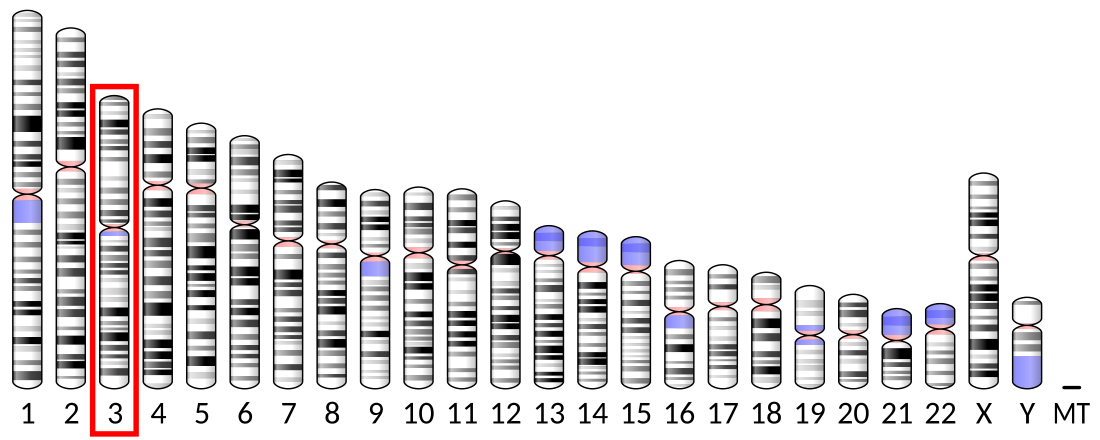Cereblon
Protein in humans From Wikipedia, the free encyclopedia
Cereblon is a protein that in humans is encoded by the CRBN gene.[5] The gene that encodes the cereblon protein is found on the human chromosome 3, on the short arm at position p26.3 from base pair 3,190,676 to base pair 3,221,394. CRBN orthologs are highly conserved from plants to humans.[5]
| CRBN | |||||||||||||||||||||||||||||||||||||||||||||||||||
|---|---|---|---|---|---|---|---|---|---|---|---|---|---|---|---|---|---|---|---|---|---|---|---|---|---|---|---|---|---|---|---|---|---|---|---|---|---|---|---|---|---|---|---|---|---|---|---|---|---|---|---|
| |||||||||||||||||||||||||||||||||||||||||||||||||||
| Identifiers | |||||||||||||||||||||||||||||||||||||||||||||||||||
| Aliases | CRBN, MRT2, MRT2A, Cereblon | ||||||||||||||||||||||||||||||||||||||||||||||||||
| External IDs | OMIM: 609262; MGI: 1913277; HomoloGene: 9461; GeneCards: CRBN; OMA:CRBN - orthologs | ||||||||||||||||||||||||||||||||||||||||||||||||||
| |||||||||||||||||||||||||||||||||||||||||||||||||||
| |||||||||||||||||||||||||||||||||||||||||||||||||||
| |||||||||||||||||||||||||||||||||||||||||||||||||||
| |||||||||||||||||||||||||||||||||||||||||||||||||||
| |||||||||||||||||||||||||||||||||||||||||||||||||||
| Wikidata | |||||||||||||||||||||||||||||||||||||||||||||||||||
| |||||||||||||||||||||||||||||||||||||||||||||||||||
Function
Ubiquitination and role in development
Cereblon forms an E3 ubiquitin ligase complex with damaged DNA binding protein 1 (DDB1), cullin-4A (CUL4A), and regulator of cullins 1 (ROC1).[6] This complex ubiquitinates a number of other proteins and marks them for degradation via the proteasome. Through a mechanism which has not been completely elucidated, this ubiquitination results in reduced levels of fibroblast growth factor 8 (FGF8) and fibroblast growth factor 10 (FGF10). FGF8 in turn regulates a number of developmental processes, such as limb and auditory vesicle formation. The net result is that this ubiquitin ligase complex is important for limb outgrowth in embryos.[7]
In the absence of cereblon, DDB1 forms a complex with DDB2 that functions as a DNA damage-binding protein. Furthermore, cereblon and DDB2 bind to DDB1 in a competitive manner.[7]
Regulation of potassium channels
Cereblon binds to the large-conductance calcium-activated potassium channel (KCNMA1) and regulates its activity.[8][9] Moreover, mice lacking this channel develop neurological disorders.[10]
Clinical significance
Summarize
Perspective
Birth defects
The drug thalidomide binds to cereblon and changes which substrates can be degraded by it, which leads to an antiproliferative effect on myeloma cells and possibly the teratogenic effect on fetal development.[7][11][12][13] Thalidomide was used as a treatment for morning sickness from 1957 until 1961 but was withdrawn from the market after it was discovered that it caused birth defects.[14] It is estimated that 10,000 to 20,000 children were affected.[15] However, the idea that cereblon modulation is responsible for the teratogenic activity of thalidomide in the chick and zebrafish was cast into doubt due to a 2013 report that pomalidomide (a more potent thalidomide analogue) does not cause teratogenic effects in these same model systems even though it binds with cereblon more strongly than thalidomide.[16][17]
Intellectual disability
Mutations in the CRBN gene are associated with autosomal recessive nonsyndromic intellectual disability,[5] possibly as a result of dysregulation of calcium-activated potassium channels in the brain (see below) during development.[7]
Targeted protein degradation
Based on the finding that thalidomide and related analogues bind CRBN, heterobifunctional molecules were designed linking thalidomide to ligands for other proteins of interest.[18][19] These molecules, termed proteolysis targeting chimeras (PROTACs) or protein degraders, recruit CRBN to a protein of interest, leading to its ubiquitination and subsequent degradation. This technology is being explored in clinical trials by a number of biotechnology companies such as Arvinas, C4 Therapeutics, and Kymera Therapeutics.[20]
References
Further reading
External links
Wikiwand - on
Seamless Wikipedia browsing. On steroids.




